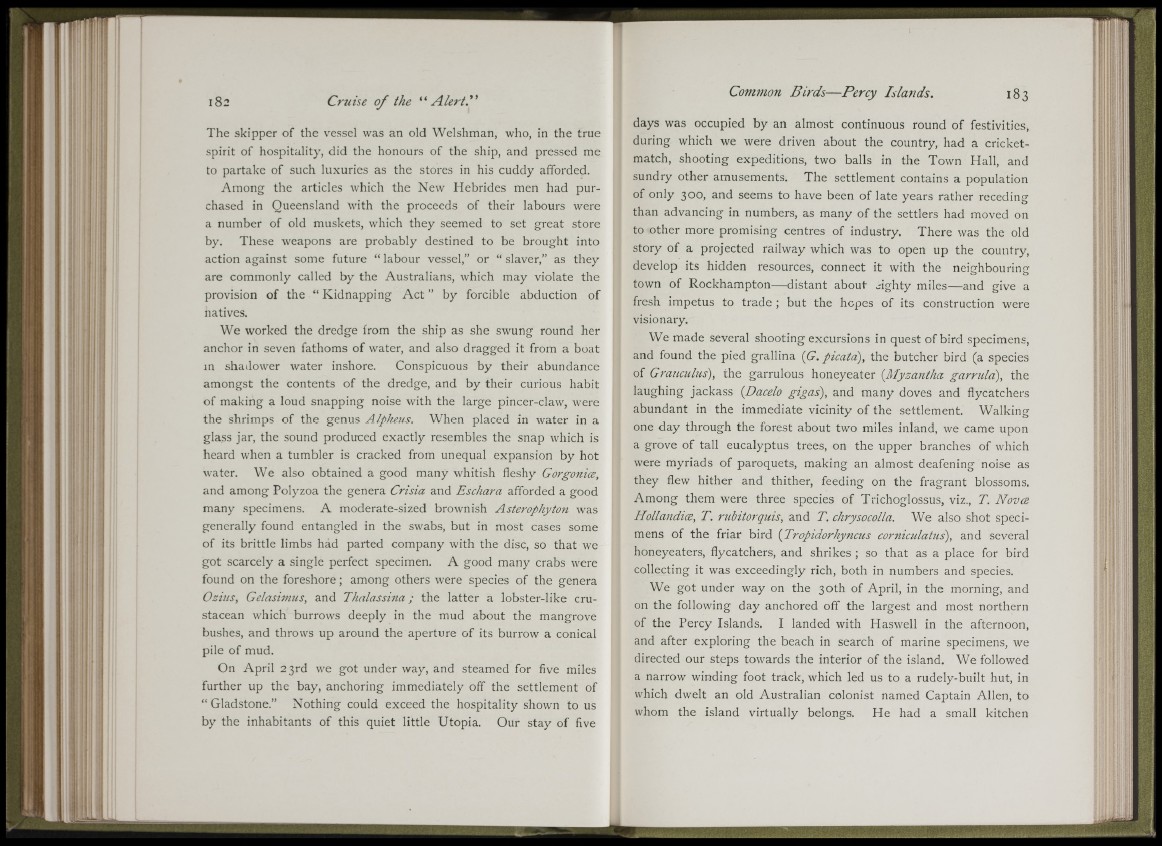
is ■3« ■- ^5 aL 2. «
i ■'s
i I HI i! '*
i J i : -
! i lW
ri I' :: i3t : . J
Y ' M'l:
■ II l"
■ ' "ii !:i
; :ii
1 Ite Ii ii:'l
■ L ; ;'"!
! I ' l
: ,j . I l i '
■ i
1- I »
’
..¡I.
I
;}■ ■ {
The skipper of the vessel was an old Welshman, who, in the true
spirit of hospitality, did the honours of the ship, and pressed me
to partake of such luxuries as the stores in his cuddy afforded.
Among the articles which the New Hebrides men had purchased
in Queensland with the proceeds of their labours were
a number of old muskets, which they seemed to set great store
by. These weapons are probably destined to be brought into
action against some future “ labour vessel,” or “ slaver,” as they
are commonly called by the Australians, which may violate the
provision of the “ Kidnapping Act ” by forcible abduction of
natives.
We worked the dredge from the ship as she swung round her
anchor in seven fathoms of water, and also dragged it from a boat
m shallower water inshore. Conspicuous by their abundance
amongst the contents of the dredge, and by their curious habit
of making a loud snapping noise with the large pincer-claw, were
the shrimps of the genus Alpheus. When placed in water in a
glass jar, the sound produced exactly resembles the snap which is
heard when a tumbler is cracked from unequal expansion by hot
water. We also obtained a good many whitish fleshy Gorgonice,
and among Polyzoa the genera Crisia and Eschara afforded a good
many specimens. A moderate-sized brownish Asterophyton was
generally found entangled in the swabs, but in most cases some
of its brittle limbs had parted company with the disc, so that we
got scarcely a single perfect specimen. A good many crabs were
found on the foreshore; among others were species of the genera
Ozius, Gelasimus, and Thalassina; the latter a lobster-like crustacean
which burrows deeply in the mud about the mangrove
bushes, and throws up around the aperture of its burrow a conical
pile of mud.
On April 23rd we got under way, and steamed for five miles
further up the bay, anchoring immediately off the settlement of
“ Gladstone.” Nothing could exceed the hospitality shown to us
by the inhabitants of this quiet little Utopia. Our stay of five
days was occupied by an almost continuous round of festivities,
during which we were driven about the country, had a cricket-
match, shooting expeditions, two balls in the Town Hall, and
sundry other amusements. The settlement contains a population
of only 30O) ^nd seems to have been of late years rather receding
than advancing in numbers, as many of the settlers had moved on
to other more promising centres of industry. There was the old
story of a projected railway which was to open up the country,
develop its hidden resources, connect it with the neighbouring
town of Rockhampton— distant about eighty miles— and give a
fresh impetus to trade ; but the hopes of its construction were
visionary.
We made several shooting excursions in quest of bird specimens,
and found the pied grallina {G. picata), the butcher bird (a species
of Grauculus), the garrulous honeyeater {Myzantha garrula), the
laughing jackass {Dacelo gigas), and many doves and flycatchers
abundant in the immediate vicinity of the settlement. Walking
one day through the forest about two miles inland, we came upon
a grove of tall eucalyptus trees, on the upper branches of which
were myriads of paroquets, making an almost deafening noise as
they flew hither and thither, feeding on the fragrant blossoms.
Among them were three species of Trichoglossus, viz., T. Novca
Elollandice, T. rubitorquis, and T. chrysocoUa. We also shot specimens
of the friar bird [Tropidorhyncus corniculatus), and several
honeyeaters, flycatchers, and shrikes ; so that as a place for bird
collecting it was exceedingly rich, both in numbers and species.
We got under way on the 30th of April, in the morning, and
on the following day anchored off the largest and most northern
of the Percy Islands. I landed with Haswell in the afternoon,
and after exploring the beach in search of marine specimens, we
directed our steps towards the interior of the island. We followed
a narrow winding foot track, which led us to a rudely-built hut, in
which dwelt an old Australian colonist named Captain Allen, to
whom the island virtually belongs. He had a small kitchen
il. . P !Qi'.ili
Ì
' I',
I' ;
!
■I ^' lI ;r.k